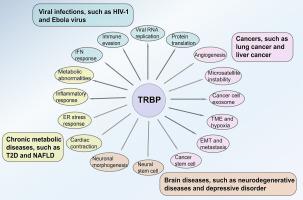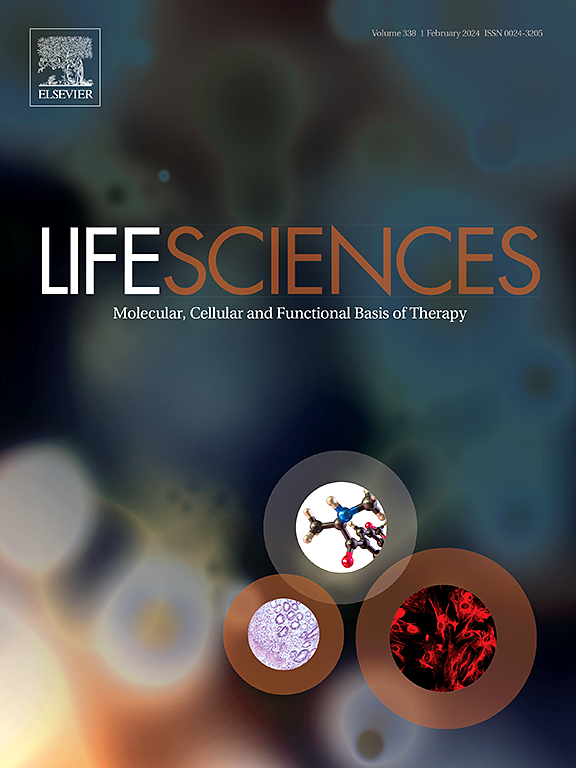New insights into the function and therapeutic potential of RNA-binding protein TRBP in viral infection, chronic metabolic diseases, brain disorders and cancer
IF 5.2
2区 医学
Q1 MEDICINE, RESEARCH & EXPERIMENTAL
引用次数: 0
Abstract
RNA-binding proteins (RBPs) and non-coding RNAs are crucial trans-acting factors that bind to specific cis-acting elements in mRNAs, thereby regulating their stability and translation. The trans-activation response (TAR) RNA-binding protein (TRBP) recognizes precursor microRNAs (pre-miRNAs), modulates miRNA maturation, and influences miRNA interference (mi-RNAi) mediated by the RNA-induced silencing complex (RISC). TRBP also directly binds and mediates the degradation of certain mRNAs. Thus, TRBP acts as a hub for regulating gene expression and influences a variety of biological processes, including immune evasion, metabolic abnormalities, stress response, angiogenesis, hypoxia, and metastasis. Aberrant TRBP expression has been proven to be closely related to the initiation and progression of diseases, such as viral infection, chronic metabolic diseases, brain disorders, and cancer. This review summarizes the roles of TRBP in cancer and other diseases, the therapeutic potential of TRBP inhibition, and the current status of drug discovery on TRBP.

对 RNA 结合蛋白 TRBP 在病毒感染、慢性代谢性疾病、脑部疾病和癌症中的功能和治疗潜力的新认识。
RNA 结合蛋白(RBPs)和非编码 RNA 是重要的反式作用因子,它们与 mRNA 中特定的顺式作用元件结合,从而调节其稳定性和翻译。反式激活反应(TAR)RNA 结合蛋白(TRBP)能识别前体 microRNA(pre-miRNA),调节 miRNA 的成熟,并影响由 RNA 诱导的沉默复合体(RISC)介导的 miRNA 干扰(mi-RNAi)。TRBP 还能直接结合并介导某些 mRNA 的降解。因此,TRBP 是调节基因表达的枢纽,影响着多种生物过程,包括免疫逃避、代谢异常、应激反应、血管生成、缺氧和转移。事实证明,TRBP 的异常表达与病毒感染、慢性代谢性疾病、脑部疾病和癌症等疾病的发生和发展密切相关。本综述概述了 TRBP 在癌症和其他疾病中的作用、抑制 TRBP 的治疗潜力以及 TRBP 药物研发的现状。
本文章由计算机程序翻译,如有差异,请以英文原文为准。
求助全文
约1分钟内获得全文
求助全文
来源期刊

Life sciences
医学-药学
CiteScore
12.20
自引率
1.60%
发文量
841
审稿时长
6 months
期刊介绍:
Life Sciences is an international journal publishing articles that emphasize the molecular, cellular, and functional basis of therapy. The journal emphasizes the understanding of mechanism that is relevant to all aspects of human disease and translation to patients. All articles are rigorously reviewed.
The Journal favors publication of full-length papers where modern scientific technologies are used to explain molecular, cellular and physiological mechanisms. Articles that merely report observations are rarely accepted. Recommendations from the Declaration of Helsinki or NIH guidelines for care and use of laboratory animals must be adhered to. Articles should be written at a level accessible to readers who are non-specialists in the topic of the article themselves, but who are interested in the research. The Journal welcomes reviews on topics of wide interest to investigators in the life sciences. We particularly encourage submission of brief, focused reviews containing high-quality artwork and require the use of mechanistic summary diagrams.
 求助内容:
求助内容: 应助结果提醒方式:
应助结果提醒方式:


